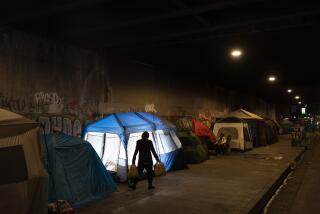An Uncommon Ministry in Cold Heart of Boston
- Share via
BOSTON — The days are cold and hard; the nights, harsher still. As winter locks its grip on the poor and homeless here, it would seem easy to rage against God: to wonder, where is the benevolence of life on the streets?
Forty-six-year-old Gary Huber finds the question baffling. He has lived on the streets, in shelters and for many years in the wilderness. Fourteen times he has been pronounced dead, he says, from drugs, from alcohol, from exposure, from who knows what, he says.
“God protects me,” Huber says. He is a tall, fearsomely thin man wearing a strange array of clothes. Huber finds God in the hardest of circumstances: “I gotta, or I’m dead.”
Outside on the Boston Common one icy Sunday, this is the prevailing view among congregants at the Common Cathedral, an open-air church that ministers to those whom society might just as soon forget. For four years now, the Rev. Deborah W. Little has brought together old people, young people, sick people and especially, homeless and mentally ill people. Their numbers are enlarged by the well-dressed men and women who stroll from their homes on elegant Beacon Hill to join Little’s services. Others drive each Sunday from the calm comfort of the suburbs to the park downtown that dates from the American Revolution.
In Common Cathedral, they find a highly unusual religious community that assembles outdoors on public space. In Little they find a spirited 54-year-old who serves peanut butter and jelly sandwiches after she preaches. Little ran the communications office at Harvard Law School until 1993, when, for reasons she still has trouble explaining, she decided to become an Episcopal priest. All she can say is, “A great big drop of grace fell in the middle of my heart.”
In jeans and a fleece jacket that makes her look like a woolly blue lamb, she is anything but churchy. Slender and blond, Little is a physical clone of the women here who drive around in Volvo station wagons with Labrador retrievers in the back. That, in fact, is the life she thought she’d have. But a “painful, itchy feeling” brought her out to the streets, to a life of service.
With so many obstacles in their lives, Little says she is constantly amazed by the steadfast faith of her congregants--and by how consistently un-angry most of them are.
“Their conversations with God are so basic,” she reflects. “I think that is exactly what Jesus is telling us about why we should go to the poor to learn who God is.”
Little’s sidewalk church was launched on Easter Sunday four years ago when she rolled a cart covered with a piece of her grandmother’s table linen onto Boston Common. Sixteen people showed up at the site near such landmarks as the gold-domed state Capitol and the original Filene’s Basement. “See you next Sunday,” they told her. So Little kept coming back.
Even on the bleakest of Boston days, the Common Cathedral soon grew to include a regular congregation of about 100 people--not counting the tourists who stop by to watch and end up joining hands to sing hymns, or the youth groups from the suburbs who show up to see poverty firsthand.
City officials who at first sputtered that Little had no permit to assemble, much less hand out free food, soon forgot their objections. Little’s own Episcopal diocese opened the doors to St. Paul’s Cathedral, just opposite Boston Common, so the group could hold weekday Eucharists indoors.
Gentle and nonthreatening, Little has drawn nothing but accolades for her work.
Still, “I think there are probably people who are not enamored of the publicness of what Deb does,” says Philip Mangano, executive director of the Massachusetts Housing and Shelter Alliance.
“So much money has been spent to hide this embarrassing political problem called homelessness. Deb makes the problem public, and I don’t doubt that there are people who don’t want to be confronted with it,” he said.
Most of Common Cathedral’s $80,000-per-year budget comes from grants and donations. Slightly more than half of that makes up Little’s salary, the diocesan minimum for a priest. Most of what’s left, she says, goes to copying--and peanut butter and jelly.
As in many cities, most of Boston’s shelters began as church-sponsored efforts. But as the homeless population grew to around 5,000, so did its needs. Separation of church and state is a powerful premise, and once government money became part of the equation, Mangano says, “the spiritual component went right out the window.”
Food, clothing, shelter and some modicum of health care are of course vital, but those who work with the homeless say a nod to the less tangible necessities of life also is critical. Desperation often turns people toward some higher authority.
“They tried to beat Jesus down too,” Huber observes. “Just like me, just like so many of us out here, no matter how many times I go down, I’m gonna come back.”
Another Common Cathedral member, 50-year-old Bill, says he stopped attending his childhood church 30 years ago because “it was filled with self-loathing hypocrites.” Many churchgoers also looked askance at a man with long, stringy hair and only a few randomly placed teeth, says Bill, who lived on the streets for 20 years before securing city-sponsored housing.
The Common Cathedral, says Bill, “seemed like a miracle to me. I had often prayed for a church that would take care of the lowest.”
More to Read
Sign up for Essential California
The most important California stories and recommendations in your inbox every morning.
You may occasionally receive promotional content from the Los Angeles Times.










